The New Vrindaban community is creating a spiritual Disneyland,
a place to enjoy and be amazed by, while you learn the highest truth.
by Kundali dasa
The impressive picture you see here is an artist’s conception of the Temple of Understanding, an eighteen-story architectural masterpiece designed by M. Mutiah Staphati of Madras, India, to be built in New Vrindaban, a burgeoning community of the International Society for Krishna Consciousness (ISKCON) in the West Virginia panhandle. The temple, iridescent and gleaming with gold-leaf trim, will be the first of its kind in North America. In fact, even in India such an architectural feat has not been attempted in almost five hundred years. The 25-million-dollar Temple of Understanding will be the main attraction in the Land of Krishna, a one-hundred-acre complex that will include sculptures, botanical gardens, art galleries, multimedia exhibits, a planetarium, and more—all aimed at educating visitors in the sublime philosophy of Krsna consciousness.

New Vrindaban, founded by His Divine Grace A.C. Bhaktivedanta Swami Prabhupada, is a sixteen-year-old Hare Krsna community, located near Wheeling in the hills of West Virginia about half an hour south of Interstate 70. Under the guidance of Srila Kirtanananda Swami Bhaktipada, New Vrindaban has grown from very humble beginnings to a thriving, diversified community of more than five hundred members. In 1968 New Vrindaban was but a handful of devotees, a couple of ramshackle buildings, and a few hundred acres of mostly wooded land. Today, spanning more than four thousand acres, it is a beehive of activity with some twenty workshops and studios, a school, a press, a two-hundred-cow dairy barn under construction, and one of the state’s most gorgeous and famous architectural wonders, Prabhupada’s Palace of Gold.
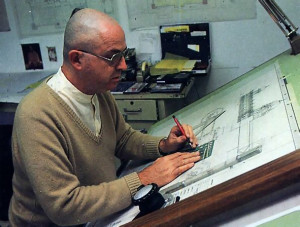
The New Vrindaban community vaulted to international acclaim in 1979 with the opening of the Palace of Gold, which blends the richness and beauty of Indian architectural design with American technological know-how. (See BACK TO GODHEAD 16/6.) The Palace, a creation of marble, onyx, stained glass, gold-leaf, crystal, and teak, has attracted an estimated 2.5 million people in the five years since it opened. As one reporter put it, “The Palace of Gold has to be seen to be believed.” One visitor called it “the Hare Krsna equivalent of the Sistine Chapel,” and the news media has dubbed it “the Taj Mahal of the West.”
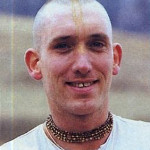
Srila Prabhupada’s Palace of Gold is the first phase of the master plan for the Land of Krishna, which is scheduled to be completed in 1996. The aim of the project is to inspire and enlighten people about Lord Krsna, the Supreme Personality of Godhead. “In the mundane world,” says Srila Bhaktipada, “there is Disneyland. We are creating a spiritual Disneyland, where people can enjoy and be amazed, but at the same time learn something worthwhile.”

Visitors—or pilgrims, if you will—to the Land of Krishna will have to plan to stay at least six days to take in all the tours and programs that will be offered. (Small wonder that the master plan calls for two one-hundred-room hotels). The site for the entire project is a tract of ridge land divided into three sectors. Each sector will have a different focus and will require an average of two days to tour.
Sector one, the Home of the Spiritual Masters, will cover about forty acres and will include the Palace of Gold, which will be surrounded by beautifully landscaped gardens. Already some thirty thousand annually-flowering plants, forty thousand spring-flowering bulbs, and five thousand summer-flowering bulbs, plus shrubs and evergreens, have been planted. These gardens and others yet to come will provide year-round beauty and fragrance. The atmosphere should be exhilarating.

Other features to be included in sector one are sculptures, large pools, a performing arts center, and a conservatory housing tropical plants from around the world. The walkway from the Palace to the conservatory will be lined with three hundred crab-apple trees. In the nearby Valley of Guru and Gauranga, two forty-foot-high images of Lord Caitanya and Lord Nityananda* [*Lord Caitanya and Lord Nityananda are Lord Krsna and Lord Balarama. who appeared in India five hundred years ago in the roles of devotees of Krsna to teach love of God through the chanting of the Hare Krsna mantra.] will stand overlooking a two-million-gallon lake. In this lake a beautiful swan-shaped boat for taking the Deities of Radha and Krsna on boat rides will be kept in an ornate boathouse resembling a little temple. In the performing arts center, episodes from the two great Sanskrit epics Mahabharata and Ramayana will be staged weekly.

Visitors to the Home of the Spiritual Masters will learn what a bona fide spiritual master is, and they’ll hear stories from the lives of the past great spiritual masters in the disciplic line. By the end of the first two days, visitors will have an understanding of why one needs a spiritual master, the distinguishing characteristics of a bona fide spiritual master, the importance of the system of disciplic succession, and so on. This sector is scheduled for completion in 1986 and will cost an estimated ten million dollars.
Next (on the third day) begins the tour of the second sector, the Krsna Book Forest Park. This section is conceived as an interlude between the deep philosophical experience of sector one and the overwhelming majesty and splendor to come in sector three. The Krsna Book Forest Park will emphasize sweetness and beauty. It will be a botanical haven, with thousands of rare trees and plants. The Park will feature thirteen specially designed and landscaped sites, where the main boyhood pastimes of Lord Krsna will be depicted in sculpture. More than five hundred heroic-size sculptures (nine-foot-high children and twelve-foot-high adults) will be cast or carved to re-create these pastimes. Why such huge sculptures? The devotees hope that the visual impact will create a strong impression. Thus, for the rest of their lives, visitors to Krsna Book Forest Park will be able to relish the memory of the transcendental pastimes that the Supreme Personality of Godhead performed five thousand years ago in Vrndavana, India.
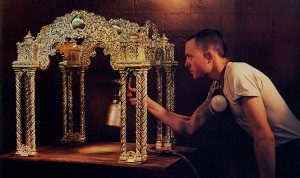
One of the highlights of the Krsna Book Forest Park will be a zoo housing animals from Krsna’s pastimes; peacocks, monkeys, elephants, and even parrots that chant Hare Krsna. Another feature of the Park will be an observation tower from which visitors can survey most of the Land of Krishna. This will be a photographer’s delight. Krsna Book Forest Park will consist of about thirty-two acres and will cost an estimated fifteen million dollars. Its completion is scheduled for 1989.
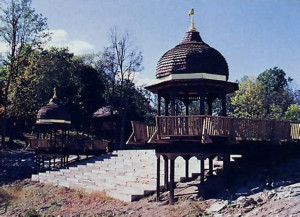
The tour of sector three will begin on the fifth day of the Land of Krishna pilgrimage and will highlight the Temple of Understanding. The structure will be 240 feet square at its base and will rise over 160 feet high. To enter the temple, visitors will traverse an 800-foot walkway—past the Seven Pools of Mercy, through the Plaza of Life, with its reflecting pool, and into the temple through a portico supported by six elephant columns. Once in the lobby visitors may take stairs or elevators up to the main floor of the temple, or they may go to the dining hall, with a capacity for three thousand, where they will enjoy delicious prasadam. Hare Krsna vegetarian cuisine.
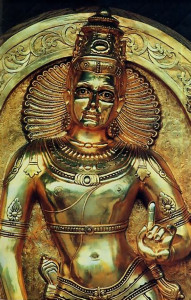
In the middle of the main floor will he the Kirtana Hall. sixty feet square. On the far side of the hall will be three altars. On one altar will be enthroned the presiding Deities of New Vrindaban, Sri Sri Radha Vrndavanacandra, and on the other two will he Deities of other manifestations of the Lord, Before entering the Kirtana Hall, tour groups will view an orientation film, explaining the practice of Deity worship in the process of Krsna consciousness. Afterwards, visitors will be taken before the Deities.
Other features on the main floor will be a Vedic Science Hall, an Exhibition Hall, and a Philosophy Hall and Planetarium, where spectacular multimedia shows will be presented. The halls of the main floor will be decorated in sacred South Indian motifs.
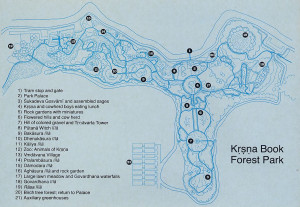
Leaving the main floor and ascending the tower over the Kirtana Hall, guests may go out onto the roof of the main floor and wander in the gardens of rare roses and other flowers, or they may continue up into the Tower of the Holy Name. As they ascend they will pass through galleries of devotional art masterpieces by members of the Krsna consciousness movement and famous works from India. In the upper levels of the tower there’ll be exhibits depicting the Vaikuntha worlds, the spiritual realm. On the topmost level will be a shrine, and within, the transcendentally beautiful form of Nataraja-Krsna, “Krsna, the Master of Dance.” The Temple of Understanding will also house a library, various workshops, and family counseling offices.

The master plan calls for art enormous garden area behind the temple: the Gardens of Lord Caitanya. This will be similar to the Krsna Book Forest Park, except that the sculptured images will depict the pastimes of Lord Caitanya Mahaprabhu. Only those who stay six days and experience all other features of the Land of Krishna will be able to fully appreciate the confidential Gardens of Lord Caitanya.
The scheduled date for completion of the Temple of Understanding is 1996, but the opening is scheduled for 1992, which means tours will go on during the four years of the finishing touches. The third sector will occupy thirty-three acres, and the estimated cost is 25 million dollars.
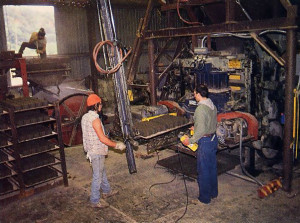
The Land of Krishna, with the Temple of Understanding at its heart, will be the center for the revival of Vedic spiritual culture in the Western world. It will be a significant contribution to the religious and cultural heritage of the United States, what to speak of bringing appreciable economic gains to the state of West Virginia. Ultimately, the devotees at New Vrindaban expect that the project will significantly improve the spiritual and moral quality of America.
The Land of Krishna project will demonstrate something that Srila Prabhupada many times expressed a desire to see. He used to say that India, being impoverished materially, is like a lame man; and America, being impoverished spiritually, is like a blind man. If the lame man gets on the shoulders of the blind man, then together they can work for their mutual benefit. In other words, the combination of India’s spiritual wisdom and America’s material opulence will be beneficial to both nations and ultimately the world. The phenomenal success of Prabhupada’s Palace of Gold gives us an indication of just how dynamic and expedient is this formula for propagating Krsna consciousness.

Of course, neither New Vrindaban, the Palace of Gold, nor the Land of Krishna project would be possible without dedicated devotees ready to face the untold trials and tribulations such a momentous project is sure to bring. Heading the list of these stalwart devotees is Srila Bhaktipada, who by his pure and consistent example of Krsna consciousness instills warmth and enthusiasm for spiritual life in his followers. He is a great source of inspiration as he makes his daily rounds, going from site to site overseeing each phase of the project’s development.
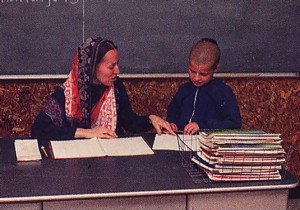
One of the chief devotees assisting Srila Bhaktipada is Kuladri dasa, president of the New Vrindaban community. Param Brahma dasa is in charge of planning and development. Murti dasa is an architect by profession who has been involved in temple building projects of the Krsna consciousness movement in India and South Africa since 1972. Sudhanur dasa, who developed many skills while working on the construction of the Palace of Gold, is in charge of design. And, of course, each resident of New Vrindaban plays some vital role in the ultimate success of the master plan.
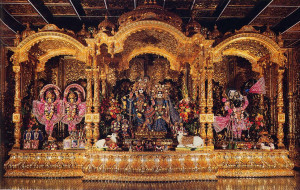
One excellent result already achieved by the project is that it has attracted support and participation from professional persons outside the New Vrindaban community, most notably from the Indian sector. Gradually, qualified persons are stepping forward and expressing a desire to work on the project, and this has been very encouraging to the devotees. One devotee explained that they especially welcome involvement by Indian experts in architecture and engineering, because it’s easier to convey ideas about structure and design to them. After all, Indians come from a cultural and religious background that comprehends the philosophy and life-style of Krsna consciousness; therefore, Indians are easier for the devotees to communicate with and are generally more sympathetic to the devotees’ cause.
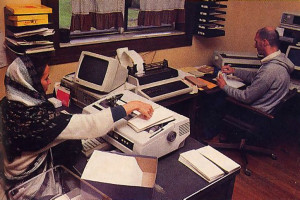
Recently at a master-plan conference, twenty experts in various aspects of architectural design and engineering volunteered to help develop what will be the most fabulous place of pilgrimage in America. Among the volunteers was Sashi Patel, a senior designer for Celli-Flynn in Pittsburgh and already a long-time supporter of the Land of Krishna project. Another senior designer from Pittsburgh who is taking an active part is Prakash Patel of Dravo-Wellman. Also, M. P. Dokai, a project manager for the Veterans Administration in Washington, D.C., has volunteered his help. At the two-day master-plan conference, committees were formed and a resolution was passed to hold quarterly meetings until completion of the project.
Although master architect M. Mutiah Stapathi, who designed the Temple of Understanding, was unable to attend the conference, his involvement remains vital to the project. Mr. Stapathi, who knows all the intricacies of traditional temple design as set forth in the Vedic literature, regularly visits New Vrindaban between trips to India and is consulted at each step of the planning.
As you can see, the Land of Krishna is a very big scheme—too big, you may think, to succeed. But the Bhagavad-gita says that wherever there is Krsna and His pure devotees, there will be success, Especially after witnessing the success of the Palace of Gold, one can’t help but think that the Land of Krishna will also be a success. As Srila Bhaktipada put it, “Krsna is not a poor fellow. He can do anything. Our responsibility is to surrender to Him. The more we surrender to Krsna, the more we become empowered by Krsna to act on Krsna’s behalf. The only problem is to surrender.”
For further information, for offering advice or suggestions, or for volunteering to help, please write to: Param Brahma dasa, ISKCON, R.D. 1, Box 3184, New Vrindaban, West Virginia 26041

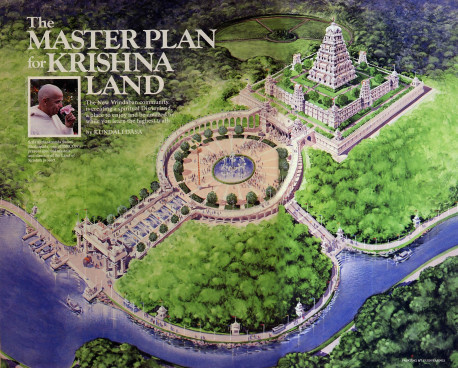
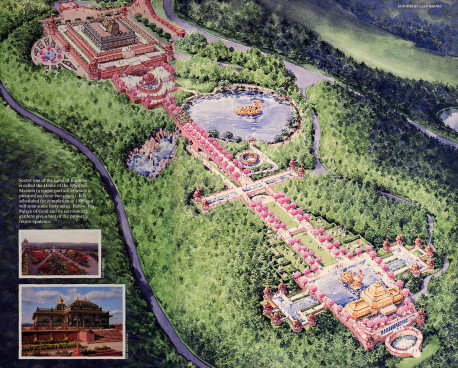
Leave a Reply